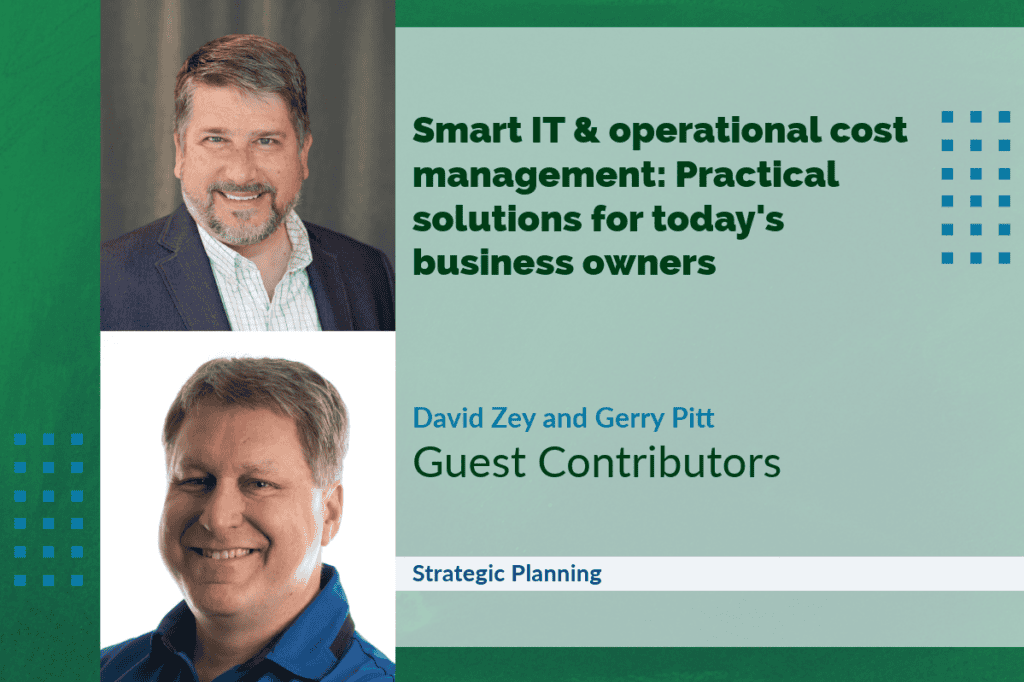
April 21, 2025
In the current, uncertain business environment (without discussing tariffs), keeping operational and IT costs under control is more critical than ever.
Many business owners have common questions about how to boost efficiency, maintain security and streamline operations without compromising quality.
In this column, we answer these common business questions while covering topics such as observing day-to-day efficiencies, continuous improvement, building a cost-conscious culture, managing vendors, controlling impulse purchases and adopting cloud-based functions.
Observing for efficiency
“Why does paying close attention to day-to-day operations matter so much for cost savings?”
Answer:
If you don’t know what’s really happening in your business, you can’t make the right adjustments.
By closely monitoring security, safety, productivity and operational stability, you can spot minor inefficiencies before they become big, expensive issues.
Quick tips:
- Implement simple, real-time reporting tools to highlight bottlenecks or threats.
- Consistently review these metrics – when you see problems early, fixing them is far cheaper than waiting for a crisis.
Continuous improvement
“We don’t want a big, expensive project that takes 20 years before we see cost savings – how is continuous improvement any different?”
Answer:
Continuous improvement doesn’t need to be about giant, one-time overhauls.
It’s a series of small-but-steady changes that start paying off quickly, often in weeks or months, not decades.
You might automate a repetitive task, streamline a process or cut an unnecessary step in the workflow.
These mini “wins” accumulate over time and lead to substantial savings without requiring a heavy upfront investment.
Quick tips:
- Look for low-hanging fruit first in areas where small fixes can deliver immediate returns.
- Encourage employees to share everyday inefficiencies; their insights often reveal quick cost-cutting opportunities. Asking for a gut-check on what “feels yucky” will often give you the starting point on those insights.
Building a cost-conscious culture
“How do I get my employees to care about cost management?”
Answer:
Start by openly sharing cost-saving goals and results.
When people see their impact on the bottom line, they may become more mindful of spending.
Incentivize them for spotting ways to save.
Quick tips:
- Offer recognition or small bonuses for creative cost-saving ideas.
- Keep everyone in the loop as transparency about finances encourages responsible spending.
“We hear it’s important to find small ways to save money every day – is that really worth it, trying to find $12 savings a day?”
Answer:
Absolutely.
Over a year, $12 a day adds up to more than $4,300, which is enough to invest in better tech or training, or to offset other rising costs.
By encouraging everyone to watch for small, everyday savings – like trimming unnecessary software subscriptions or tweaking energy usage – you can build a truly cost-conscious culture that can generate significant long-term benefits.
Managing vendors
“We rely heavily on vendors – how do I ensure I’m getting the best bang for my buck?”
Answer:
Develop clear negotiation criteria and monitor vendor performance.
Strong partnerships can lead to better pricing, higher service quality and lower risk.
Quick tips:
- Regularly review your vendor contracts and align them with your goals.
- Take advantage of on-site vendor visits that are included with your contract to be sure you’re getting the most value from their product
- If your vendors know your future plans and feel a part of them, they might offer more competitive deals that support your growth.
“We’re considering outsourcing some of our IT management. I keep hearing about MSPs, vCIOs and vCISOs – is this really worth it, and what do they offer?”
Answer:
Honestly, just saying MSPs, vCIOs and vCISOs makes you feel like you should be dancing to the “E-I-O Polka,” but behind the catchy tune is a smart strategy.
Outsourcing your IT management to an MSP (managed service provider) can really ease the pressure on your team, especially if you’re facing a shortage of tech talent.
You get access to top-notch expertise without the overhead of hiring full-time executives.
For instance, you might tap into strategic advice from a vCIO (virtual chief information officer) or get critical security oversight from a vCISO (virtual chief information security officer) on an as-needed basis.
This way, you’re only spending money on specialized help when you need it, without the long-term costs of a full-time senior hire.
What’s even better is that an MSP can flexibly scale your IT resources up during busy periods and scale back when demand drops.
They also help ensure compliance with industry regulations and offer robust disaster recovery solutions, so you’re well-prepared if something goes wrong.
In short, outsourcing isn’t just about cost-cutting – it can be a smart strategy to address skill shortages and maintain operational agility.
Quick tips:
- When outsourcing, be sure to set clear service-level agreements (SLAs) and performance expectations.
- You want flexibility and accountability, not long-term lock-in.
Controlling impulse buying (and avoiding “shiny objects”)
“We’re a mid-sized company – do we really have an impulse buying problem?”
Answer:
Even minor unplanned purchases can add up quickly.
Today’s market is flooded with “shiny new” or “gotta have it” business products and subscriptions – from AI-driven software to trendy in-industry apps – that promise to make business life easier.
Without a clear business case and ROI for the business, these impulse buys can become costly distractions.
Quick tips:
- Put a simple approval process in place: “Does this align with our top priorities?”
- Use budgeting tools that flag unbudgeted purchases.
- Ask, “Do we truly need this, or is it just the next big hype?” That brief pause can save you from a year’s worth of subscription fees or underutilized hardware.
Adopting cloud-based functions
“We’re thinking about moving more of our IT to the cloud – how does that actually save money, help us scale and strengthen security?”
Answer:
Think of the cloud like a flexible utility.
Instead of sinking a fortune into on-premises hardware, you pay only for the resources you actually use, and you can adjust those resources on the fly as your business needs change.
That alone lowers overhead.
Add in the fact that reputable cloud providers typically have strong security protocols and built-in redundancy, and your disaster recovery plan becomes much more robust than if you were trying to manage it all in-house.
Of course, it’s important to have a solid roadmap to avoid vendor lock-in or compliance headaches.
Many companies find that a hybrid or multi-cloud strategy, where some processes stay on-site while others move to one or more cloud services, strikes the right balance between cost, control and security.
Quick tips:
- Run a cost-benefit analysis before migrating any critical function.
- Sometimes, keeping certain operations on-premises is more cost-effective, while other parts of your business thrive in the cloud.
By combining observing for efficiency, continuous improvement (delivering quick, incremental savings); a cost-conscious culture (including those daily $12 savings); strategic vendor management (including outsourcing when it makes sense); impulse control; and adopting cloud-based functions to improve security and disaster recovery, your business can better meet the challenges and other uncertainties 2025 still holds (including tariffs).
These practical strategies are proven to cut costs, boost efficiency and pave the way for long-term success in Wisconsin’s competitive business environment.
 Green Bay Packaging succeeds at sustainability
Green Bay Packaging succeeds at sustainability Altoona continues to make history as U.S. birthplace of Crokicurl
Altoona continues to make history as U.S. birthplace of Crokicurl







